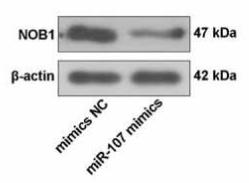NOB1 Antibody - #DF12216
| Product: | NOB1 Antibody |
| Catalog: | DF12216 |
| Description: | Rabbit polyclonal antibody to NOB1 |
| Application: | WB IHC |
| Cited expt.: | WB |
| Reactivity: | Human, Mouse, Rat |
| Prediction: | Pig, Zebrafish, Bovine, Horse, Sheep, Rabbit, Dog, Chicken, Xenopus |
| Mol.Wt.: | 47-50 kDa; 47kD(Calculated). |
| Uniprot: | Q9ULX3 |
| RRID: | AB_2845021 |
Related Downloads
Protocols
Product Info
*The optimal dilutions should be determined by the end user. For optimal experimental results, antibody reuse is not recommended.
*Tips:
WB: For western blot detection of denatured protein samples. IHC: For immunohistochemical detection of paraffin sections (IHC-p) or frozen sections (IHC-f) of tissue samples. IF/ICC: For immunofluorescence detection of cell samples. ELISA(peptide): For ELISA detection of antigenic peptide.
Cite Format: Affinity Biosciences Cat# DF12216, RRID:AB_2845021.
Fold/Unfold
Adenocarcinoma antigen recognized by T lymphocytes 4; ART 4; ART4; MST158; MSTP158; Nin one binding protein; NIN1/RPN12 binding protein 1 homolog (S. cerevisiae); nob1; NOB1_HUMAN; NOB1P; Phosphorylation regulatory protein HP-10; Protein ART-4; Protein ART4; PSMD8 binding protein 1; PSMD8BP1; RNA binding protein NOB1; RNA-binding protein NOB1;
Immunogens
A synthesized peptide derived from human NOB1, corresponding to a region within C-terminal amino acids.
- Q9ULX3 NOB1_HUMAN:
- Protein BLAST With
- NCBI/
- ExPASy/
- Uniprot
MAPVEHVVADAGAFLRHAALQDIGKNIYTIREVVTEIRDKATRRRLAVLPYELRFKEPLPEYVRLVTEFSKKTGDYPSLSATDIQVLALTYQLEAEFVGVSHLKQEPQKVKVSSSIQHPETPLHISGFHLPYKPKPPQETEKGHSACEPENLEFSSFMFWRNPLPNIDHELQELLIDRGEDVPSEEEEEEENGFEDRKDDSDDDGGGWITPSNIKQIQQELEQCDVPEDVRVGCLTTDFAMQNVLLQMGLHVLAVNGMLIREARSYILRCHGCFKTTSDMSRVFCSHCGNKTLKKVSVTVSDDGTLHMHFSRNPKVLNPRGLRYSLPTPKGGKYAINPHLTEDQRFPQLRLSQKARQKTNVFAPDYIAGVSPFVENDISSRSATLQVRDSTLGAGRRRLNPNASRKKFVKKR
Predictions
Score>80(red) has high confidence and is suggested to be used for WB detection. *The prediction model is mainly based on the alignment of immunogen sequences, the results are for reference only, not as the basis of quality assurance.
High(score>80) Medium(80>score>50) Low(score<50) No confidence
Research Backgrounds
May play a role in mRNA degradation (Probable). Endonuclease required for processing of 20S pre-rRNA precursor and biogenesis of 40S ribosomal subunits (By similarity).
Nucleus.
Detected in liver, lung, placenta, endothelial cells and spleen.
Belongs to the NOB1 family.
Research Fields
· Genetic Information Processing > Translation > Ribosome biogenesis in eukaryotes.
References
Application: WB Species: Human Sample: FaDu cells
Restrictive clause
Affinity Biosciences tests all products strictly. Citations are provided as a resource for additional applications that have not been validated by Affinity Biosciences. Please choose the appropriate format for each application and consult Materials and Methods sections for additional details about the use of any product in these publications.
For Research Use Only.
Not for use in diagnostic or therapeutic procedures. Not for resale. Not for distribution without written consent. Affinity Biosciences will not be held responsible for patent infringement or other violations that may occur with the use of our products. Affinity Biosciences, Affinity Biosciences Logo and all other trademarks are the property of Affinity Biosciences LTD.










